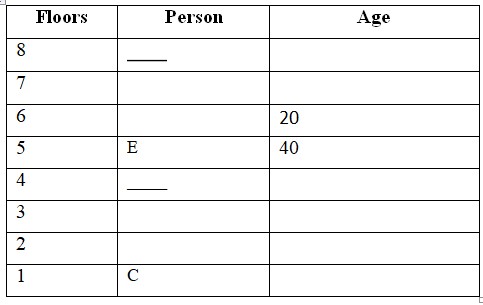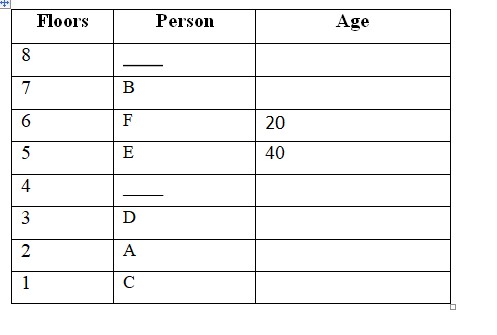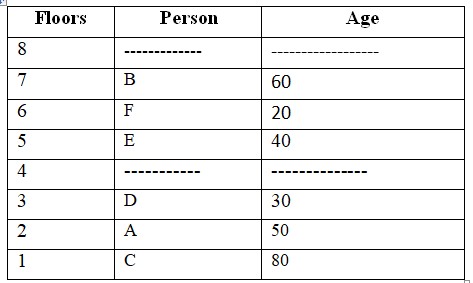Question
Four of the following five are alike to in a certain way
and so form a group. Which one of the following does not belong to the group? Study the following information carefully to answer the given questions. Six people – A, B, C, D, E and F live in eight different floors of a building (but not necessarily in the same order). Two of the floors in the building are vacant. The lowermost floor of the building is numbered one, the one above that is numbered two, and so on till the topmost floor is numbered eight. Each of them is of different ages – 20 30, 40, 50, 60 and 80 but not in same order. The one who is the youngest lives on one of the floors above the floor numbered 5. The one whose age is 40 lives immediately below the one who is youngest. The age of the person who lives on the ground floor is the sum of the ages of the persons who lived on the floors numbered 7 and 6. The age of the person who lives on the ground floor is not 60. The number of floors above E is same as the number of floors between E and C. E lives an odd numbered floor above the floor numbered four. There are three people live between the two vacant floors. The floor numbers of the vacant floors are even – number. Only three floors are there between C and the one whose age is 40. B lives immediately above F. Only three floors are there between F and A. Only two floors are there between A and E. D lives on one of the floors below the floor numbered 4. The sum of the ages of the person who lives on second and third floor equals to the age of the person who lives on the ground floor. A’s age is more than D.Solution
There are three people live between the two vacant floors. The floor numbers of the vacant floors are even – number. The one who is the youngest lives on one of the floors above the floor numbered 5. The one whose age is 40 lives immediately below the one who is the youngest. Vacant floor cannot be 2 and 6 age of the person who lives on the ground floor is the sum of the ages of the persons who lived on the floors numbered 7 and 6. So, the vacant floor is floor no. 8 and other vacant floor is floor no. 4. The one who is the youngest lives on the floor no. 6 and the one whose age is 40 lives on the floor no. 5. The number of floors above E is same as the number of floors between E and C. E lives an odd numbered floor above the floor numbered four. Only three floors between C and the one whose age is 40. E lives on the floor no. 5, then C lives on the floor no. 1.  B lives immediately above F. Only three floors between F and A. Only two floors are there between A and E. D lives on one of the floors below the floor numbered 4. A lives on floor no. 2 and F lives on floor no. 6. B lives on floor no. 7. D lives on floor no. 3.
B lives immediately above F. Only three floors between F and A. Only two floors are there between A and E. D lives on one of the floors below the floor numbered 4. A lives on floor no. 2 and F lives on floor no. 6. B lives on floor no. 7. D lives on floor no. 3.  The age of the person who lives on the ground floor is the sum of the ages of the persons who lived on the floors numbered 7 and 6. The age of the person who lives on the ground floor is not 60. The sum of the ages of the person who lives on second and third floor equals to the age of the person who lives on the ground floor. A’s age is more than D. We know that the age of the person who lives on the ground floor is not 60. We know that A age is more than D. We have two numbers remaining 30 and 50. The sum of these two is 80. So, A and D’s ages are 50 and 30 respectively. The age of the person who lives on the ground floor is 80. The age of the person who lives on the ground floor is the sum of the age of the persons who lived on the floors numbered 7 and 6 i.e. 60 + 20 = 80.
The age of the person who lives on the ground floor is the sum of the ages of the persons who lived on the floors numbered 7 and 6. The age of the person who lives on the ground floor is not 60. The sum of the ages of the person who lives on second and third floor equals to the age of the person who lives on the ground floor. A’s age is more than D. We know that the age of the person who lives on the ground floor is not 60. We know that A age is more than D. We have two numbers remaining 30 and 50. The sum of these two is 80. So, A and D’s ages are 50 and 30 respectively. The age of the person who lives on the ground floor is 80. The age of the person who lives on the ground floor is the sum of the age of the persons who lived on the floors numbered 7 and 6 i.e. 60 + 20 = 80. 
Shadow Paging avoids:
Which of the following is not part of the process control block (PCB)?
Which normal form ensures that every determinant is a candidate key?
Which join should be used when you want to list all customers and any orders they may have placed, including customers who haven’t placed any orders?
Which operation is NOT part of relational algebra?
Which normal form ensures no partial dependency of non-prime attributes on a candidate key?
Which type of relationship exists when a record in one table can relate to multiple records in another table, and vice versa?
Which normal form removes partial dependency?
During transaction before commit which of the following statements is done automatically in case of shutdown?
Which of the following concurrency control methods avoids deadlocks entirely but can reduce concurrency by blocking transactions at start?


